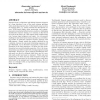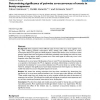8 search results - page 1 / 2 » Finding relevant patterns in bursty sequences |
PVLDB
2008
13 years 9 months ago
2008
Sequence data is ubiquitous and finding frequent sequences in a large database is one of the most common problems when analyzing sequence data. Unfortunately many sources of seque...
BMCBI
2008
13 years 9 months ago
2008
Background: Event sequences where different types of events often occur close together arise, e.g., when studying potential transcription factor binding sites (TFBS, events) of ce...
BMCBI
2008
13 years 9 months ago
2008
Background: Motif finding algorithms have developed in their ability to use computationally efficient methods to detect patterns in biological sequences. However the posterior cla...
ISMB
1994
13 years 10 months ago
1994
Weconsider the problem of parsing a sequence into different classes of subsequences.Twocommonexamplesare finding the exons and introns in genomicsequences and identifying the seco...
ALMOB
2006
13 years 9 months ago
2006
Background: In order to compute pattern statistics in computational biology a Markov model is commonly used to take into account the sequence composition. Usually its parameter mu...


